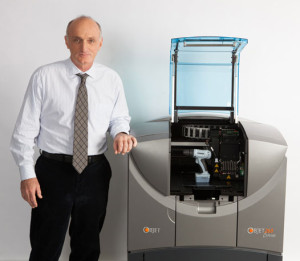During the last week both 3D Systems and its main 3D printing rival, Stratasys, released their 2013 financials and it looks like a year of rapid growth, acquisitions and mergers seem to be paying off for both companies. Stratasys is reportedly enjoying a more stable growth thanks to its high profile mergers with Objet and MakerBot, while the aggressive and expensive acquisition of many untested 3D printing start-ups in such a short period may have slightly reduced 3D Systems’ profits in the Fourth Quarter.
Stratasys ended the fourth quarter with $155.1 million in revenue — that’s more than a 60% increase on the previous year. The company was able to start the year off in a better position thanks to the merger with Objet in late 2012 providing a full year of increased revenue and market share. Even without the contributions of MakerBot in the fourth quarter, Stratasys saw an increase in hardware revenue of 38% and consumable revenue of 33% over 2012 for a combined organic revenue increase of 36%. However, when you factor in the $24.9 million dollars in revenue brought in the fourth quarter due to the MakerBot acquisition it brings Stratasys to an impressive 62% increase in total revenue for the year.
Much of Stratasys’ rapid growth was due to these wise mergers, giving it a much larger catalogue of successful printers and access to the US market that was already fond of the MakerBot 3D printers. 2013 also saw the introduction of the Objet500 Connex3 3D printer as well as its three new versions of the blockbuster MakerBot Replicator line of inexpensive 3D printers, due to start shipping this year. Additionally the company expanded the online MakerBot 3D Ecosystem and entered into a strategic partnership with Dell that will see the MakerBot Replicator included with their new Dell Precision Workstations for small and medium sized business.

3D Systems had a pretty impressive year too. Its fourth quarter revenue increased 52% from last year to a record $154.8 million with a gross profit increase of 53%, however the company’s profit margin remained a flat 51.7% with no growth from the previous period. For the full year they saw a revenue increase of 45% to a record $513.4 million and they saw their full year gross profit increase by 48% while their gross profit margin jumped to 52.1%.
Here are some fourth quarter and yearly highlights as broken down by individual printer categories:
Fourth Quarter 2013 Revenue Highlights (compared to 2012 quarter):
- 3D printers and other products revenue increased 76% to $73.9 million.
- Print materials revenue grew 39% to $37.2 million.
- Services revenue rose 33% to $43.7 million.
- Healthcare revenue increased 67% to $21.8 million.
- Consumer solutions expanded 162% to $8.9 million.
Full Year 2013 Revenue Highlights (compared to 2012):
- 3D printers and other products revenue increased 80% to $227.6 million.
- Print materials revenue grew 24% to $128.4 million.
- Services revenue rose 27% to $157.4 million.
- Healthcare revenue increased 45% to $71.7 million.
- Consumer solutions expanded 206% to $34.8 million.

Rather than focusing on a slow and steady expansion of its services and offerings, 3D Systems continued its much publicised 3D Printing industry company shopping spree last year that may have dampened the end of year profits. Additionally the company committed $16.6 million to R&D in the fourth quarter, more than doubling the previous year’s $7.8 million. 3D Systems also had to commit to expanding its manufacturing capacity due to increasing demand and the launching of 24 new products in just one year. According to Reichental, 3D Systems plans to double its revenue over the next few years and the late-quarter reduction in earnings was due to the focus on accelerating growth and expanding market share. This focus on expansion rather than profit has 3D Systems’ management predicting revenue growth between $680 to $720 million by the end of 2014.
Reichental concluded: “We believe that 3D Printing is at the cusp of accelerated growth and that the ultimate measure of our success will be the sustainable value we create from our share and scale gains over time. While our stepped up actions and investments pressured our quarterly earnings, we believe that our actions set the stage to substantially compress the time it will take us to extend and solidify our leadership position and deliver greater value.”
2013 was a great year for the 3D printing industry overall, and the impressive growth and expansion shown by the industry’s two largest companies bodes well for everyone. Interestingly both companies took some pretty radically different paths to their success — as they have since they first went toe to toe in the early 90’s — and I’m sure in 2014 we will continue to see both companies aggressively expand their market share and industry presence. Of course increasing market share in a rapidly expanding industry driven by emergent technology isn’t necessarily difficult. The tricky part comes when the market stabilizes and companies have to shift from expanding their market share to keeping it. Only time will tell which company has taken the route that will offer future stability.




